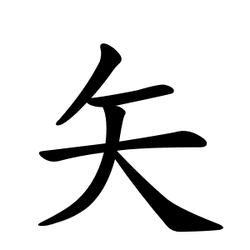Radical 111
| 矢 | ||
|---|---|---|
| ||
| 矢 (U+77E2) "arrow" | ||
| Pronunciations | ||
| Pinyin: | shǐ | |
| Bopomofo: | ㄕˇ | |
| Wade–Giles: | shih3 | |
| Cantonese Yale: | chi2 | |
| Jyutping: | ci2 | |
| Japanese Kana: | シ shi (on'yomi) や ya (kun'yomi) | |
| Sino-Korean: | 시 si | |
| Names | ||
| Chinese name(s): | 矢字旁 shǐzìpáng | |
| Japanese name(s): | 矢/や ya 矢偏/やへん yahen | |
| Hangul: | 화살 hwasal | |
| Stroke order animation | ||
 | ||
Radical 111 or radical arrow (矢部) meaning "arrow" is one of the 23 Kangxi radicals (214 radicals in total) composed of 5 strokes.
In the Kangxi Dictionary, there are 64 characters (out of 49,030) to be found under this radical.
矢 is also the 110th indexing component in the Table of Indexing Chinese Character Components predominantly adopted by Simplified Chinese dictionaries published in mainland China.
Evolution
-
 Oracle bone script character
Oracle bone script character -
 Bronze script character
Bronze script character -
 Large seal script character
Large seal script character -
 Small seal script character
Small seal script character
Derived characters
| Strokes | Characters |
|---|---|
| +0 | 矢 |
| +2 | 矣 |
| +3 | 矤 知 |
| +4 | 矦 矧 矨 |
| +5 | 矩 |
| +6 | 矪 矫 |
| +7 | 矬 短 |
| +8 | 矮 |
| +12 | 矯 矰 |
| +14 | 矱 |
| +15 | 矲 |
Sinogram
As an independent sinogram 矢 is a Chinese character that means arrow. It is one of the kyōiku kanji or kanji taught in elementary school in Japan.[1] It is taught in second grade.
References
- ^ "The Kyoiku Kanji (教育漢字) - Kanshudo". www.kanshudo.com. Archived from the original on March 24, 2022. Retrieved 2023-05-06.
Further reading
- Fazzioli, Edoardo (1987). Chinese calligraphy : from pictograph to ideogram : the history of 214 essential Chinese/Japanese characters. calligraphy by Rebecca Hon Ko. New York: Abbeville Press. ISBN 0-89659-774-1.
- Lunde, Ken (Jan 5, 2009). "Appendix J: Japanese Character Sets" (PDF). CJKV Information Processing: Chinese, Japanese, Korean & Vietnamese Computing (Second ed.). Sebastopol, Calif.: O'Reilly Media. ISBN 978-0-596-51447-1.
External links
Wikimedia Commons has media related to Radical 111.